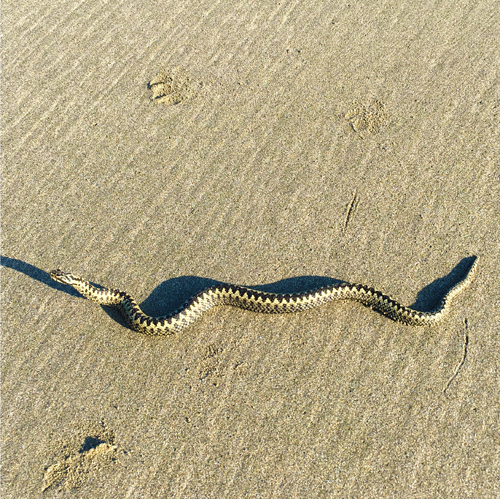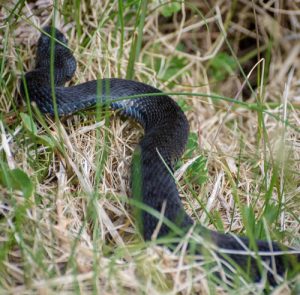 When Patrick said to me that he had seen a black adder on the Roseland I found it hard to believe, as the only black adder reference I knew of was from the television series with Rowan Atkinson!
When Patrick said to me that he had seen a black adder on the Roseland I found it hard to believe, as the only black adder reference I knew of was from the television series with Rowan Atkinson!
It’s been quite a summer for adders, so watch out, especially if you let your dog off the lead on the coastal footpaths or beaches. See Chris’s photo of an adder on the Wild Roseland Facebook page wriggling along Carne Beach! However, adders will usually only bite if they are disturbed or antagonised. Records show there have only been around 10 cases of death to humans from adder bites in the last hundred years.
The name comes from the Old English for serpent. It is our only venomous snake, is about 60 cm in length, twice that of a slow worm, but only half the length of the grass snake at 1.2 metres.
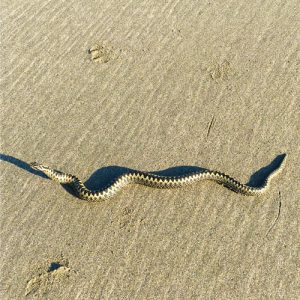 The sightings brought back memories from one of our regular contributors, Keith, who recollected that he had seen one about 3 years ago in the same area. As adders are believed to have a life span of 15 to 20 years it is highly likely that it was the same one or one of its offspring.
The sightings brought back memories from one of our regular contributors, Keith, who recollected that he had seen one about 3 years ago in the same area. As adders are believed to have a life span of 15 to 20 years it is highly likely that it was the same one or one of its offspring.
Young adders are born as miniatures of their mother, who leaves her traditional hibernation site to have between 3 and 12 offspring so that they can grow in the safety of undergrowth, particularly bracken. She only looks after them for a few hours after birth. After that they are on their own.
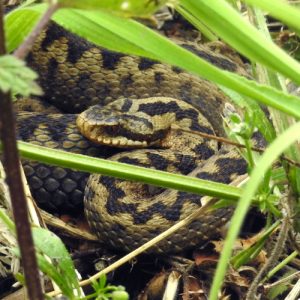 One curious fact about adders is that they are ovoviviparous; ie their eggs are incubated inside their bodies and then the young are hatched shell less. The grass snake on the other hand lays eggs.
One curious fact about adders is that they are ovoviviparous; ie their eggs are incubated inside their bodies and then the young are hatched shell less. The grass snake on the other hand lays eggs.
Research shows that while adders always have the distinctive zigzag pattern down their backs, they can indeed be a variety of colours and some are pure black. Grass snakes vary much less and always have a distinctive yellow collar and round pupils in their eyes. The adder has red eyes with a vertically slit pupil, unmistakeable in identification, if you get that close!
Whatever you think, they are protected by law. It is illegal to deliberately kill, injure or sell wild adders.
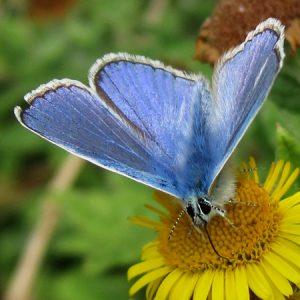 What else to look out for this month in the Roseland – Butterflies!
What else to look out for this month in the Roseland – Butterflies!
It’s been a good summer for the butterflies, and Butterfly Conservation want you to record your sightings, to discover which species are thriving and which are simply surviving. All you need to do is download their free app or chart, choose a sunny spot and spend just 15 minutes watching the natural world go by.
Record your wildlife sightings!
The Roseland area is under-recorded for its wildlife flora and fauna. If you see anything of interest then do please add your observations to the Wildlife Trust’s ORCS database here. All data gets added to the NBN database, making it retrievable by anyone interested in doing research, locally, nationally or internationally.
Contributors:
Article by David Hall. Images: Black adder by Patrick Rigley. Adder on Carne beach by Chris Giles. Adder in vegetation by Sarah Vandome.
Edited by Sarah Vandome.
Wild Roseland is a group of volunteers who care passionately about looking after the nature and landscape of the Roseland peninsula in south Cornwall. Through a number of initiatives and projects, the aim is to inspire and enhance the conservation of this special place for all.
References and links
Wild Roseland – http://www.wildroseland.org/
Enjoy more Roseland wildlife and landscapes – visit Sarah Vandome’s Heart of Roseland Facebook feature:
https://www.facebook.com/HeartOfRoseland?ref=hl
Wild Roseland is on Facebook.

